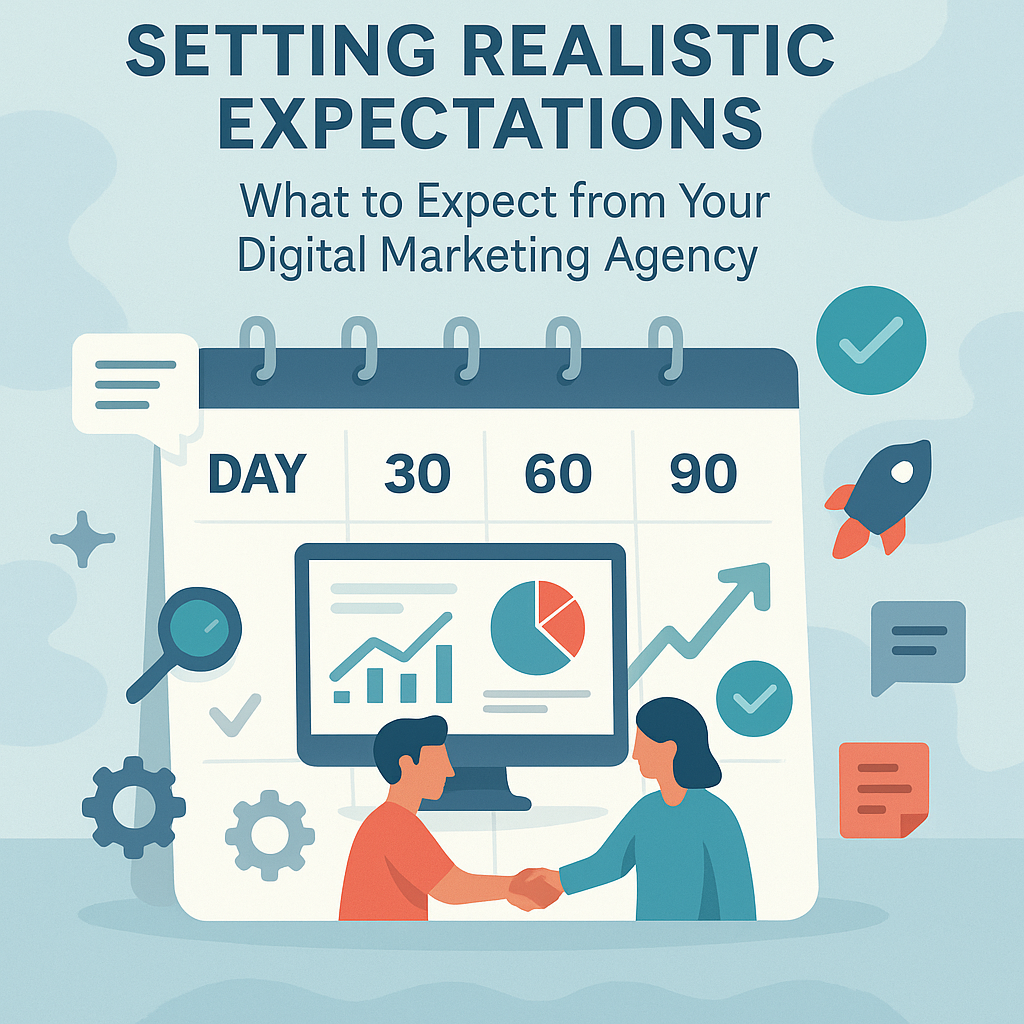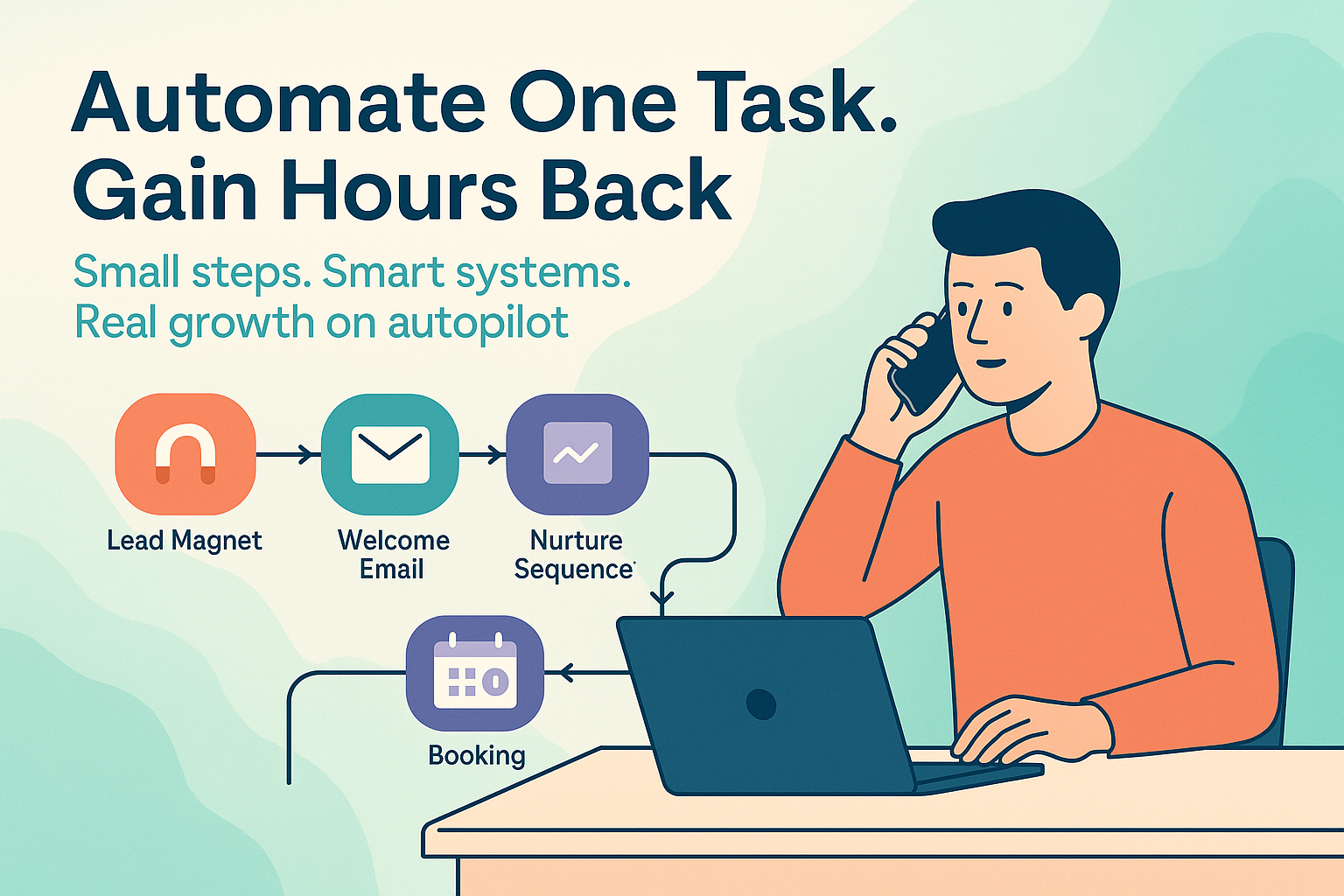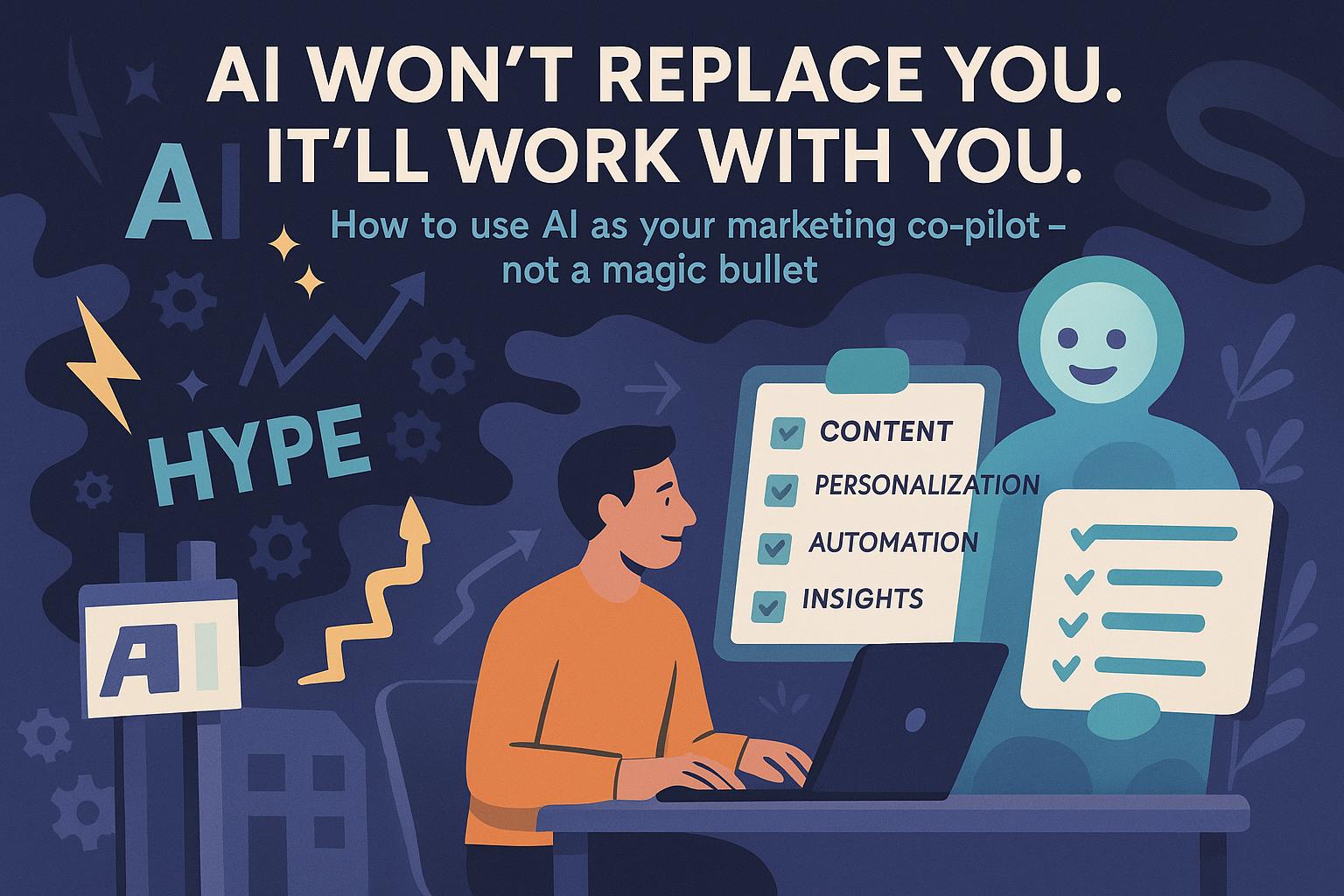Digital marketing conversations can often sound like a different language. An agency might throw out terms like SEO, CPC or retargeting, and suddenly you feel like everyone’s speaking code. You’re not alone—many business owners feel overwhelmed by marketing jargon and worry that they’ll make the wrong decisions because they don’t understand the terms. The good news? You don’t need a marketing degree to understand the basics. This glossary breaks down 15 core concepts into plain English and explains why each one matters for your company’s growth. Think of it as a friendly cheat sheet that empowers you to ask better questions, evaluate proposals confidently and work with your digital marketing partner more effectively.
The Big Picture: Strategy Terms
The first category covers high‑level strategies that shape your digital presence. They are the tools that help your business get found, tell its story and build relationships online. When marketers talk about these concepts, they’re describing the overarching methods used to attract visitors and convert them into loyal customers.
Search Engine Optimization (SEO)
SEO is the practice of optimizing your website so it shows up higher in search results when people look for products or services like yours. That means adjusting your site’s structure, making sure each page targets relevant keywords and improving content quality. When done right, SEO helps your business get discovered by people who are already looking for what you offer. For a deeper dive on how SEO works in today’s competitive landscape, check out our SEO services.
Search Engine Marketing (SEM)
Search Engine Marketing is the paid counterpart to SEO. Rather than earning traffic organically, SEM involves buying ads on search platforms (like Google Ads) so your business appears at the top of results for chosen keywords. These campaigns are also called pay‑per‑click ads because you pay only when someone clicks on your listing. SEM can deliver quick visibility, making it useful for promoting time‑sensitive offers or testing new product ideas. Once you understand SEM fundamentals, you’ll be better equipped to evaluate whether a paid search campaign is right for your goals.
Content Marketing
Content marketing involves creating helpful, relevant articles, videos, podcasts or guides that answer your audience’s questions and demonstrate your expertise. Instead of pushing a sales pitch, you provide value—think how‑to guides, success stories or tips. Over time, this approach builds trust and nurtures leads, leading prospects to see your brand as the solution. Effective content marketing also supports your SEO efforts by giving search engines more quality material to index. Our content marketing services can help you craft a strategy tailored to your audience.
Social Media Marketing (SMM)
Social media marketing uses platforms like Facebook, Instagram, LinkedIn or TikTok to connect with potential customers, engage current ones and build brand awareness. Businesses share stories, post updates, interact in comments and run ads targeting specific audiences. These channels allow you to humanize your brand, gather feedback and reach people where they’re already spending time. A well‑run social media program works hand in hand with content marketing: your posts drive traffic to your website while your articles give followers something meaningful to read.
The Language of Performance: Metrics and Analytics
Once your strategies are in place, you need to measure how they’re working. The following terms describe the metrics used to judge campaign effectiveness and financial impact. Knowing these numbers helps you see where your marketing dollars are producing a return and where adjustments are needed.
Return on Investment (ROI)
Return on investment compares what you spend on marketing to the revenue those efforts generate. A positive ROI means your campaigns are making more than they cost. If you spend $1,000 on ads and earn $5,000 in sales directly linked to those ads, your ROI is 5:1. Tracking ROI helps you make smart budgeting decisions and identify which channels deliver the best results.
Key Performance Indicator (KPI)
A KPI is a measurable value that shows how effectively a campaign or strategy achieves a specific goal. KPIs can include traffic numbers, conversion rates, social media engagement or revenue. They act as the scorecard for your marketing efforts. Before launching any initiative, decide on the KPIs that matter most, and review them regularly to see if you’re on track.
Conversion Rate
Your conversion rate is the percentage of visitors who complete a desired action, such as filling out a form, scheduling an appointment or making a purchase. It’s calculated by dividing the number of conversions by the total number of visitors and multiplying by 100. A higher conversion rate means your website or marketing funnel is effectively persuading people to take action. Improving this metric typically involves better landing pages, persuasive copy and targeted offers.
Click‑Through Rate (CTR)
CTR measures how often people click on a link or advertisement relative to how many people saw it. For example, if your ad appears 1,000 times (impressions) and receives 50 clicks, the CTR is 5%. A strong CTR indicates that your messaging and design resonate with viewers. Marketers often experiment with headlines, visuals and calls to action to improve this rate.
Cost Per Acquisition (CPA)
Cost Per Acquisition represents the total amount you spend to acquire one paying customer on a specific campaign or channel. It’s calculated by dividing total campaign costs by the number of conversions. Unlike broader customer acquisition cost (CAC), which considers all marketing and sales expenses, CPA focuses on the immediate cost of a single campaign. This metric tells you how efficiently you’re turning advertising dollars into revenue. A lower CPA means you’re acquiring customers more economically.
Cost Per Click (CPC)
Cost Per Click (CPC) is the amount an advertiser pays each time someone clicks on their ad. CPC is often used interchangeably with pay‑per‑click (PPC), though the former refers to the actual cost while PPC describes the advertising model. Understanding CPC helps you plan budgets and evaluate the financial efficiency of different advertising platforms. For instance, search ads typically carry a higher CPC because users are expressing intent, while display ads may have a lower CPC but deliver broader brand awareness.
The Marketer’s Toolkit: Tactical Terms
Knowing strategy and metrics is half the battle. The remaining terms are practical tools marketers use every day to improve campaigns and guide audiences toward the right actions. Armed with these definitions, you’ll be able to understand recommendations and ask smart questions about implementation.
A/B Testing
A/B testing, sometimes called split testing, compares two versions of a webpage, email or advertisement to determine which performs better. For instance, you might show half of your visitors Version A of a landing page and the other half Version B with a different headline. By measuring which one converts more visitors, you can make data‑driven improvements. This technique is a simple way to refine messaging and design before scaling up.
Call to Action (CTA)
A call to action is a prompt that encourages a specific next step, such as “Buy Now,” “Subscribe,” or “Download Our Guide”. CTAs are usually placed on buttons, banners or end of blog posts. They guide prospects toward conversions by clarifying what to do next. Clear CTAs make it easy for visitors to engage and reduce friction in the buyer’s journey.
Landing Page
A landing page is a stand‑alone web page designed for a single marketing offer. It typically appears after a user clicks a search ad, email link or social media promotion. The page focuses on one call to action and removes distractions found on a broader website. Well‑crafted landing pages often include persuasive headlines, concise copy, testimonials and clear forms. The goal is to convert visitors into leads or customers without overwhelming them with too many options.
Customer Relationship Management (CRM)
A Customer Relationship Management system is software for managing interactions with leads and clients. It stores contact details, tracks communications and organizes follow‑ups so you don’t miss opportunities. For small businesses, a CRM simplifies sales and service tasks by keeping everything in one place. It can also integrate with email marketing platforms and e‑commerce systems to provide a complete picture of your customer lifecycle.
Retargeting
Retargeting (or remarketing) is a tactic that displays ads to people who have already visited your website or engaged with your content. If someone browses your product page but doesn’t buy, you can show them a targeted ad later while they’re reading the news or scrolling through social media. Because these users already know your brand, retargeting ads typically see higher engagement rates and better return on ad spend. It’s an effective way to stay top of mind and remind potential customers to complete their purchase.
How These Terms Work Together
Understanding each term individually is helpful, but the real power comes from seeing how they interconnect. For example, SEO and content marketing attract visitors to your site. Once visitors arrive, a strong landing page and compelling CTA encourage them to take the next step. Retargeting keeps your brand in front of people who’ve already shown interest, and CRM software ensures you follow up with every lead. Throughout this process, metrics like CTR, conversion rate, CPA and ROI show you what’s working. Regular A/B testing and KPI tracking help refine campaigns, while SEM and social media marketing provide channels for amplifying your message. When these tactics work in concert, they create a cohesive digital marketing ecosystem that converts strangers into loyal advocates.
Putting It Into Practice: A Real‑World Scenario
Imagine you’re launching a new service. To begin, you identify key search terms your customers use and optimize your website’s pages for those phrases (SEO). Then you run a Google Ads campaign (SEM) targeting those same keywords. Each ad leads to a specific landing page with a persuasive headline, brief overview of your offer and a clear CTA to book a consultation. You set up a CRM to track every lead that fills out the form.
As traffic flows in, you monitor your CTR to see whether the ads attract clicks and watch your conversion rate to assess whether the landing page persuades visitors to submit their details. If conversions are low, you A/B test different headlines or CTA buttons. After acquiring customers, you calculate your CPA to ensure the campaign is profitable. You continue nurturing leads by sending helpful articles and case studies (content marketing) and sharing news on social channels (SMM). For visitors who didn’t convert, you implement a retargeting campaign to remind them about your service. Throughout the process, ROI and KPIs guide your decisions, ensuring you allocate budget where it generates the most impact.
Simple Tips for Getting Started
If you’re new to digital marketing, these terms might seem like a lot to absorb. Here are straightforward steps to help you put this glossary into action:
Define clear KPIs for each campaign. Decide which metrics—such as conversion rate, CTR or CPA—will signal success.
Begin with one channel, like SEO or a single paid search campaign, and build from there. Spreading your budget too thin makes it hard to learn what works.
Set up a CRM early so you don’t lose track of leads. Many entry‑level options are affordable and easy to use.
Create valuable content that addresses common customer questions. Over time, this will help your SEO efforts and provide material for email newsletters.
Experiment and test. Small A/B tests can lead to big improvements in conversions and click‑through rates.
Review your ROI regularly and shift investment toward strategies that demonstrate positive returns.
For additional context, our blog offers deep dives into some of these ideas. You might start with From Funnel to Flywheel: Rethinking the Customer Journey, which explains why customer relationships don’t end at the sale, or explore Interactive Content Marketing: Engage Your Audience to learn how quizzes and calculators can boost engagement. If you’re curious about how brand advocates contribute to marketing success, see From Influencers to Advocates: The Power of Customer‑Generated Content.
Final Thoughts
Gaining fluency in digital marketing terminology doesn’t require becoming an expert. It simply means understanding the language well enough to feel confident when you’re making decisions or evaluating recommendations. With this glossary, you have a foundation to discuss strategy, measure performance and leverage practical tools. As you continue to grow your business online, you’ll find that familiarity with terms like SEO, CPA and CRM helps you collaborate more effectively with marketers and avoid miscommunication. In our next installment of The Client’s Guide to Digital Marketing Success, we’ll show you how to translate your business goals into a comprehensive marketing brief—without drowning in jargon.
Grab your free Glossary now and start feeling confident about every term.(295.1 KB)


